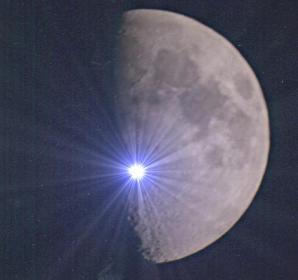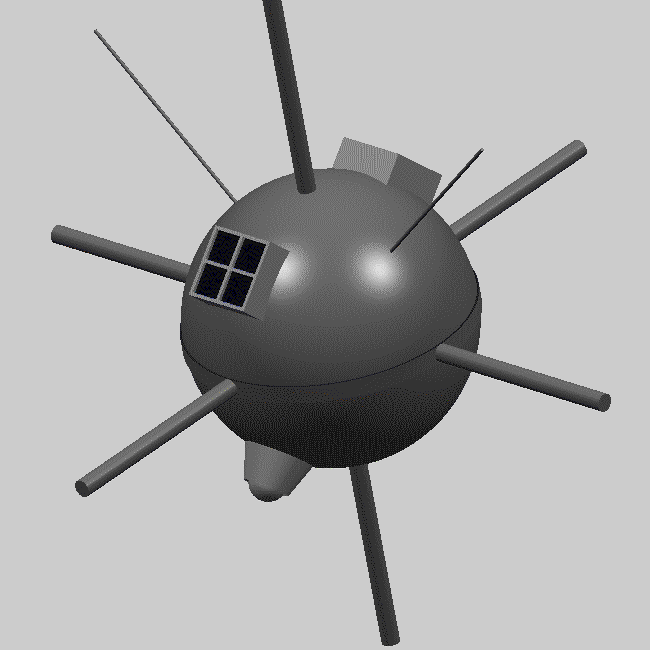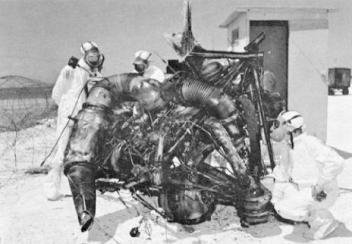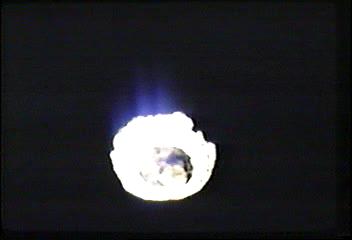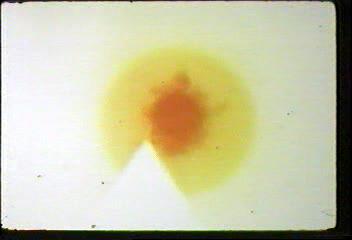|
Last Updated: October 13, 2002
The first idea of exploding a bomb on the lunar surface seems to be in Robert Goddard's "A Method for reaching extreme altitudes". Goddard investigated the possibility of reaching the Moon with a rocket loaded with photographer magnesium powder, in order to record the explosion made by the impact. Instead of carrying out a simple theoretical study, in October 1916 Goddard made an experiment to establish the minimum powder mass to be carried by the rocket. By observing at night from his Worcester home the magnesium flash made in an air evacuated glass ampule located some 3,600 meters away, he determined that the flash made by 0.0029 grams of magnesium was barely visible and the one made by 0.015 grams was plainly so. Frome these data he calculated that, using a 30 cm diameter telescope to observe the impact, the rocket was to carry 1.2 kg of magnesium for the flash to be barely visible and 6.27 kg to be plainly so. To carry this mass to the moon, Goddard estimated that it was necessary to use a rocket of some fifteen tons launch mass, able to accelerate the payload to escape speed. Goddard himself noted that "the plan of sending a mass of flash powder to the surface of the moon, although a matter of much general interest, is not of obvious scientific importance". This was however the first idea of an interplanetary mission to do without of the presence of humans: the first "space probe". Later, in the Forties, the German born popular science writer Willy Ley further perfected the Goddard idea. He noted in fact that if the terrestrial observers able to observe the lunar impact of the magnesium laden probe were incapacitated by bad weather, the impact may happen without any witness. To counter this problem Ley proposed the impact on the Moon of 0.5 kg of high explosive and 4.5 kg of white powder, possibly powdered glass that, once dispersed on the surface, would have formed a patch of surface more brilliant than the surroundings. In 1945 US astronomer H. H. Nininger suggested the use of two new technologies developed during the most recent war, guided missiles and atomic weapons, to dislodge lunar soil samples and to carry them toward the Earth, thus providing an artificial imitation of what astronomers believed had happened during the formation of the larger craters or during the eruption of the lunar volcanoes, creating a class of natural glasses called tektites. In 1957 Kraft Ehricke, an Atlas missile designer and Nobel prize George Gamow proposed a small probe called Cow (after a nursery rhyme) that was to fly by the Moon before returning to Earth one week after launch. A follow-on version was to be preceded by an atomic bomb that was to raise a cloud of vaporized rock. The second probe was then to fly through the cloud, thus returning lunar surface samples to Earth. In October of the same year, JPL (Jet Propulsion Laboratory) presented
its idea of a lunar program that would overshadow Sputnik. The program
was called Red Socks and it could include the
detonation of an atom bomb on our natural satellite's surface, in order
to collect, as Nininger had proposed, any lunar rock that would be hurled
to our planet by the explosion and to produce, in the words of JPL's director
Pickering to produce "beneficial psychological results".
In parallel with the Able probes' development, the US Air Force started a top secret project, called A119, described euphemistically as a "study of lunar research flights" and only revealed 42 years after its conception. It was probably based on a still secret RAND Corporation study, started in 1956, aimed at putting a nuclear warhead on the Moon. The same idea was shared by Edward Teller, the father of the hydrogen bomb who in February 1957 proposed exploding an atomic bomb at some distance from the lunar surface to observe the fluorescence induced in it or even directly on the surface to observe what kind of disturbance it might cause. Moreover, after being mentioned in project ``Red Socks'', the idea of the emphatically called ISBM (InterSpatial Ballistic Missile) was analyzed in some detail by engineers of Lockheed Space and Missiles Division who determined that a 11 kTon bomb carried by an Agena rocket would have had enough time to explode before being crushed in the impact with the Moon. However, such a project would probably have been forgotten had the Soviet Union not declared an unilateral nuclear test ban on March 31, 1958. This ban was interrputed on September 30, announced by the United States on October 31 and finally accepted by the Soviet Union in December. The ban was supposed to lead to a total test ban but, for lack of an agreement, the Soviet Union resumed testing on September 1, 1960, followed by the United States four days later. Despite this, for almost two years the two superpowers did not explode a single nuclear weapon. In this climate of incertitude, it is not surprizing that the US military considered moving their own tests in space, giving them an aura of scientific respectabily. Project A119 was thus started by the US Air Force Special (i.e. nuclear) Weapons Center, its main aim being of sending to the Moon without any warning a fission atomic bomb to impress the Soviets and their allies. Very few details of the project have been revealeed, and the few ones mostly concern the scientific side. To the project in fact participated from the spring of 1958 a small group of scientists of the Armour Research Fondation of the Illinois Institute of Technology, providing scientifical consultancy on the mission. This group included many well known scientists such as Leonard Reiffel, project chief scientist and later to be the manned Apollo lunar missions scientific instrumentation manager, Gerard P. Kuiper, a Dutch born planetlogist and his doctorate student Carl Sagan, the future famous planetary astronomer, scientist popularizer and author of the science fiction novel Contact. Counting on the accuracy of the launcher, far too optimistically estimated as "a couple of miles" at the Moon's distance, it was decided to explode the bomb on the night side close to the terminator, in order to maximize visiblity. Whatever the yield of the bomb and contrary to Kuiper's calculations, the crater created by the explosion would not have been visible: a 1 kiloton bomb would have digged a 50 meters diameter crater and a 1 megaton a less than 400 meters diameter one. In contrast to the similar Soviet project of which more later, the American project never reached the mission hardware stage. We thus ignore the chosen launcher, probably an uprated version of the Atlas or Titan ICBM and the characteristics of the bomb. The final scientific report on the mission, signed by Reiffel and recently made public through the Freedom Of Information Act, envisages the possibility of usign weapons yelding as much as a megaton (one million tons of TNT) but the most probable choice, because of mass limitations, would have been a bomb at least as powerful as the one dropped on Hiroshima (some twenty kilotons). Although the aim of the mission was a different one, the report describes the possible scientific fallout of the lunar explosion, mainly relating to the possiblity of studying the thermal characteristics of the surface exposed to the explosion's heat, of collecting data on the internal structure of the Moon and particularly on the existence of a metallic nucleus, if one to three seismometers had been placed on the surface in anticipation of the explosion, of studying the rock composition and the presence of a magnetic field. Other scientific investigations related to the project were carried out by Sagan but we only know the titles of these: "Possible Contribution of Lunar Nuclear Weapons Detonations to the Solution of Some Problems in Planetary Astronomy" and "Radiological Contamination of the Moon by Nuclear Weapons Detonations". This second paper, in particular, dealt with the effects of radioactive fallout on the surface of the Moon, which could have altered Lunar geology research for centuries to come. Of course the military were not at all concerned by this problem. However, Reiffel himself was skeptical in his report of the opportunity of staging such a mission, noting that the reaction of the unprepared public opinion to the explosion of an atom bomb on the Moon would have probably been negative. As the mission was mainly designed as a public relations exercise, it is not surprising that the project was terminated in January 1959. Alas, many documents on project A119 were destroyed during the Eighties by the Illinois Institute of Technology and it is thus unlikely that other informations may surface in the future. The Soviet project was called E-4 and was to detonate an atom bomb on the visible hemisphere to provide a dramatic visual confirmation of the impact and to perform a remote chemical analysis of the soil vaporized in the explosion.. The probe weighted 400 kg and its shape was similar to an E-1 (flown as Luna-1 and Luna-2) with detonators protruding like an anti-ship mine. The yield of the weapon is not known, but it was probably quite small, considering the weight of the probe and the Soviet state of the art (for example, the RDS-4 Natasha tactical atom bomb, which entered service in 1953, yielded 30 kTons and weighted, in its air dropped version, 1200 kg). In fact, it is unlikely that the probe would have had the time to explode, since it would have hit the Moon traveling at a speed (3 km/s) close to the "speed of information" (i.e. the speed of sound) in the metal detonating system. The launcher was to be an 8K73, a uprated version of the 8K72
that launched Luna-1, Luna-2 and Luna-3. The development of the E-4 culminated
with the construction of a full scale mock-up, before being abandoned for
two main reasons. First of all, the risk of a launch abort was realized,
with the nuclear weapon falling back to Earth and landing in the Soviet
Union or in a foreign state. One can consider what happened on July
25, 1962 during operation Dominic: a Thor missile, launched from the US
base of Johnston Island, in the Pacific Ocean, and carrying a hundred kiloton
warhead that was to explode in the high atmosphere, experienced an engine
failure and was blown up while still on the pad, which was completely destroyed
and contaminated with plutonium. In three other tests of the same series
something went wrong during the flight and the warhead "safe" (i.e. non
nuclear) self destruction system was activated, which resulted in some
contamination of Pacific Ocean islands.
The Partial Test Ban Treaty, which prohibited any nuclear explosion
on the atmosphere or into space, entered in force in 1963 and four years
later the Treaty
on Principles Governing the Activities of States in the Exploration and
Use of Outer Space, Including the Moon and other Celestial Bodies,
which prohibited the stationing of nuclear weapons in space, closed forever
the page of the nuclear space probes. Before 1963, however, the US exploded
six bombs into space and the USSR four more. As late as the Seventies,
the Soviets were however still planning to explode a nuclear bomb on the
surface of Venus to calibrate seismic models of the planet.
Some images from Operation Dominic
Bibliography Aviation Week, 25 August 1958, p. 23.
Related Links
For questions, suggestions and comments you can email me |
